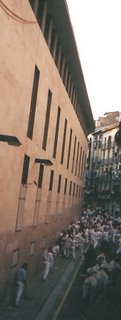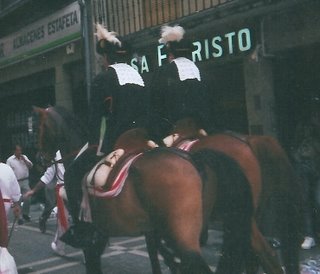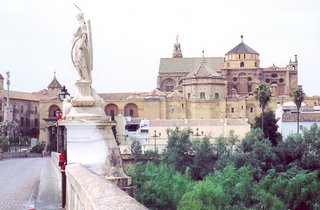 ARCHITECTURE.
ARCHITECTURE.The idea of proportion comes across despite the many forms used. Recalling here an art history lecturer in college, who used a conductor's baton to tap out architecture - the base might be tap....tap....tap; one for each major aperture.
Then, the level above, with four apertures to each one below, might be taptaptaptap; and above it, two above the four, for tap tap; and a whistle and swoop for an arch with a tap, and BANG for the cupole on top of the dome. Gets under your skin.
Make your own sound effects as you look at buildings.
 ROME REMEMBERED.
ROME REMEMBERED.Here is Neptune, in a roundabout -
Some sites start Madrid's history with medieval times, see ://www.aboutmadrid.com/madrid/history.asp. Nuts. We like to do back and back. This one is better - 1000 BC, settlement by Iberian tribes, and Celts; and in 218 BC, in came the Romans with roads, many converging here. So, that is maybe why we have Neptune here. In the 4thCentury AD, Visigothic Kings took over after Rome fell. There is a whole park lineup of them. Very impressive, macho. Toledo was the capital for the Visigoths. See://www.world66.com/europe/spain/madrid/history.
CELTS.
Always surprised that the Celts were all over Europe, including Eastern and Central Europe, later pushed into England, Wales, Ireland. See ://www.watson.org/~leigh/celts.html. Need to research more on Celts and Visigoths.
ISLAMIC EMPIRE.
10th Century: Arab. Emir Cordova Muhammad Ibn Abd al-Rahman. This site says that the Muslims founded Madrid proper. See ://cuip.uchicago.edu/wit/2000/teams/cybertour/madridhistory.htmlThe full name is listed because we want to know what each part means - a lineage, a tribute?
Liberated 11th Century.
PLAZA MAYOR.
.

Here is the great Plaza Major or Plaza Mayor - a huge space, cafes, and in the early evening the tapas gets going, with later evening (dinner starts about 11:00 PM) busy with crowds. Enter from a regular city street, up a staircase, through an arch and suddenly there it is - wide open. Wonderful.
Madrid became the capital and seat of the Royal Family in the 16th Century.

Many monuments to explorers, kings.
 Memorial to King Charles III?, 18th Century.
Memorial to King Charles III?, 18th Century.He also ruled Naples and Sicily - we often forget how fluid national boundaries were then. Find out after we get back. Reforms in sanitation, no more slops out windows, liked French dress, overall did well, says ://www.1911encyclopedia.org/Charles_III_of_Spain.
THE ROYAL PALACE.
.

This is no longer used as a residence. Meet the Royal Family at ://personales.ya.com/fororeal/infresp.htm.
King Juan Carlos I and Queen Sofia, and children.
 DON QUIXOTE AND SANCHO PANZA
DON QUIXOTE AND SANCHO PANZA CHRISTOPHER COLUMBUS
CHRISTOPHER COLUMBUSThis memorial is so tall that it took two photos to get it all in. See Dan at the bottom for scale. Is is as high as Trafalgar Square? There is a tradition that Cristoforo Colombo was a child out of wedlock, his childhood unknown, but piece together the stories and such support for it as you may choose to weigh, at Bogomilia, Shadow Children.
THE PRADO MUSEUM
If you arrive in Madrid on a Sunday and expect to see the Prado on a Monday, you will have to go elsewhere - and there are many alternative museums. Prado closes Mondays. Another choice is to hop one of the many sight-seeing buses where you get on and off all day, taking any of the many routes offered - just go all over for the price of one ticket. Great.
 Pamplona, Spain. Dawn, by the Corral
Pamplona, Spain. Dawn, by the Corral Pamplona, Spain. The Runners Amass
Pamplona, Spain. The Runners Amass Pamplona, Spain. The Rocket, the Bull Run, with a few oxen.
Pamplona, Spain. The Rocket, the Bull Run, with a few oxen. Pamplona, Spain. The Great Scatter at the Bull Running
Pamplona, Spain. The Great Scatter at the Bull Running Pamplona, Spain. Mounted Police, in Feathers. End of Day.
Pamplona, Spain. Mounted Police, in Feathers. End of Day. Pamplona, Parade, Spain
Pamplona, Parade, Spain
 Malaga, Alcazabe, Spain. Sun Coast.
Malaga, Alcazabe, Spain. Sun Coast. Alcazabe, Malaga, Spain. Wall View.
Alcazabe, Malaga, Spain. Wall View. Bilbao, Museum of Modern Art, Spider on the Side
Bilbao, Museum of Modern Art, Spider on the Side Granada, Spain. Alhambra garden courtyard
Granada, Spain. Alhambra garden courtyard Alhambra, Granada, Spain, Lion Fountain
Alhambra, Granada, Spain, Lion Fountain Albaicin, Arab Quarter, Old Grenada, Spain (view from the Alhambra)
Albaicin, Arab Quarter, Old Grenada, Spain (view from the Alhambra) Burgos, Cathedral, Spain
Burgos, Cathedral, Spain Cordoba, Roman Temple, Claudius Marcellus
Cordoba, Roman Temple, Claudius Marcellus Cordoba, Spain. RomanTemple setting, on street, Claudia Calle Marcelo
Cordoba, Spain. RomanTemple setting, on street, Claudia Calle Marcelo Cordoba, Roman Bridge
Cordoba, Roman Bridge Cordoba, Puente Romana
Cordoba, Puente Romana Cordoba, Cathedral incorporating the Mosque
Cordoba, Cathedral incorporating the Mosque Cordoba, Guadalquivir River
Cordoba, Guadalquivir River Roman Bridge, Cordoba, Spain
Roman Bridge, Cordoba, Spain Cathedral, Cordoba, Spain
Cathedral, Cordoba, Spain Spanish Synagogue, Prague, CZ
Spanish Synagogue, Prague, CZ
 Gibraltar, Mosque
Gibraltar, Mosque Alcazar, Segovia, Spain
Alcazar, Segovia, Spain Big roast pig. Do not confuse with the delicate roast suckling pig, cochinillo asado, Spain
Big roast pig. Do not confuse with the delicate roast suckling pig, cochinillo asado, Spain Puerto LaPice, Spain, Street scene
Puerto LaPice, Spain, Street scene Don Quixote, Puerto LaPice, Spain. Trough.
Don Quixote, Puerto LaPice, Spain. Trough. Don Quixote and Dulcinea, El Toboso, Spain
Don Quixote and Dulcinea, El Toboso, Spain Cadiz, Spain
Cadiz, Spain Salamanca, Spain, Cathedral facade
Salamanca, Spain, Cathedral facade Salamanca, Spain, Shell House
Salamanca, Spain, Shell House Salamanca, Spain, Plaza Mayor
Salamanca, Spain, Plaza Mayor Salamanca, Spain, Plaza Major, Performers
Salamanca, Spain, Plaza Major, Performers Salamanca, Spain, Musicians
Salamanca, Spain, Musicians Merida, Spain
Merida, Spain Theater, Merida, Spain
Theater, Merida, Spain Bridge, Gaudiana River, Merida, Spain
Bridge, Gaudiana River, Merida, Spain Amphitheater, Merida, Spain; including water tank facility for reenactments, naval spectacles
Amphitheater, Merida, Spain; including water tank facility for reenactments, naval spectacles  Cuenca, Spain, Plaza Mayor, main square
Cuenca, Spain, Plaza Mayor, main square Daniel Widing conversing Fernando Zobel, we think, Cuenca, Spain
Daniel Widing conversing Fernando Zobel, we think, Cuenca, Spain